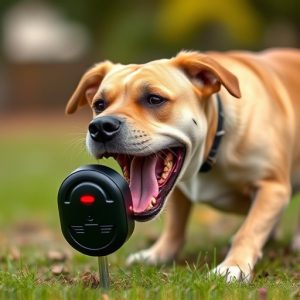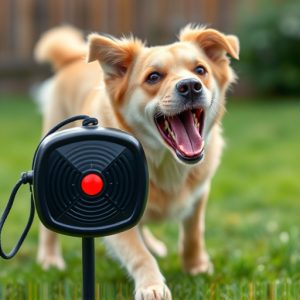Sonic Dog Repellent Systems: Safety, Effectiveness, and Implementation Guide
Dog repellent devices using ultrasonic technology offer a safe and effective solution for managing c…….
Dog repellent devices using ultrasonic technology offer a safe and effective solution for managing canine access in areas like gardens and patios, emitting high-frequency sound waves above 20 kHz that are distressing to dogs but harmless to humans. Compliance testing is crucial to ensure these pet-friendly tools meet safety standards, guarantee their effectiveness, and promote environmental consciousness among homeowners and businesses. Strategic implementation involves choosing a device tailored for target animals, strategic installation, regular maintenance, monitoring sound levels, and recording test results. Strict adherence to protocols ensures reliable and safe animal deterrence while meeting regulatory requirements, specifically for dog repellent device compliance testing.
“Animals, especially dogs, can sometimes cause a nuisance in urban settings. This is where an Animal Control Sonic Repellent System steps in as a modern solution. This article explores an innovative approach to managing canine behavior with a focus on dog repellent devices. We delve into the science behind these devices, emphasizing the importance of compliance testing for safety and efficacy. Additionally, we provide a practical guide on implementing and maintaining such systems, offering a step-by-step approach to effective animal control.”
- Understanding Dog Repellent Devices: The Basics and Their Functionality
- Compliance Testing for Sonic Repellents: Ensuring Safety and Efficacy
- Implementing and Maintaining the System: A Step-by-Step Guide for Effective Animal Control
Understanding Dog Repellent Devices: The Basics and Their Functionality
Dog repellent devices, also known as ultrasonic repellents, have gained popularity as a humane and effective way to deter dogs from entering specific areas. These devices operate by emitting high-frequency sound waves that are unpleasant to canines but harmless to humans and other animals. Understanding how these tools work is crucial for their successful implementation and ensuring compliance with safety standards.
The basic functionality involves converting electrical energy into sound vibrations through a speaker system. These sounds fall within the ultrasonic range, typically above 20 kHz, which is beyond human hearing but perceived as annoying or distressing to dogs. When activated, the device projects this sound in areas where dog presence needs to be controlled, such as gardens, patios, or even vehicles. Dog repellent devices are designed to be pet-friendly, safe, and environmentally conscious, making them a preferred choice for many homeowners and businesses aiming to manage canine disturbances without causing harm. Compliance testing is essential to guarantee their effectiveness and safety, ensuring they meet the required standards for ultrasonic technology.
Compliance Testing for Sonic Repellents: Ensuring Safety and Efficacy
Sonic repellent systems designed for dogs, or any animal, undergo rigorous compliance testing to ensure their safety and efficacy. These tests are essential in verifying that the ultrasonic frequencies emitted by the device are within safe sound pressure levels for both humans and animals. The process includes assessing the device’s ability to repel dogs without causing harm or discomfort, as well as its overall performance under various conditions.
Compliance testing also covers environmental impact, ensuring the devices meet certain standards for electrical safety and battery life. Moreover, these tests often involve field studies to evaluate the repellent system’s real-world effectiveness against specific dog behaviors. By adhering to stringent protocols, manufacturers can guarantee that their dog repellents are not only safe but also consistently reliable in deterring unwanted animal intrusion.
Implementing and Maintaining the System: A Step-by-Step Guide for Effective Animal Control
Implementing and maintaining an animal control sonic repellent system requires careful steps for optimal effectiveness. First, select a device designed for your specific target animals, ensuring it complies with relevant safety standards and regulations, such as those for dog repellent devices undergoing compliance testing. Install the system in areas where animal presence is a concern, strategically placing it to maximize sound coverage without causing disturbance to non-target species or neighbors. Regular maintenance involves checking battery life, cleaning sensors, and replacing any worn components to keep the system functioning at peak performance.
Additionally, monitor sound levels to avoid exceeding safe decibel limits and periodically test the device’s effectiveness against targeted animals through controlled trials. Keep records of installation details, maintenance schedules, and test results for ongoing optimization and to ensure compliance with environmental and safety regulations. Consistent adherence to these steps will contribute to a successful and sustainable animal control solution.
The implementation of a sonic repellent system, combined with rigorous Compliance Testing for Dog Repellent Devices, offers a safe and effective solution for animal control. By understanding the technology’s functionality and adhering to a well-defined maintenance guide, property owners can successfully deter unwanted canine visitors without causing harm. This innovative approach to pest management ensures a harmonious balance between human comfort and animal welfare.


